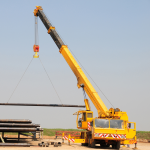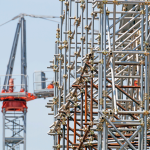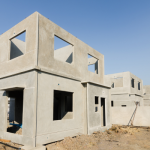Understanding Tower Cranes
Before we dive into the erection process, it's essential to understand what makes tower cranes unique. Unlike telescopic cranes, which use hydraulic pressure to lift weights up to 10-20 tons, tower cranes utilize electric motors to lift significantly heavier loads, up to 100 tons. This immense lifting capacity, combined with their ability to reach heights over 250 meters and a horizontal jib length of 70 meters, sets them apart.
Foundation and Initial Setup
The first step in erecting a tower crane is creating a robust foundation. This foundation ensures the crane remains stable and secure, preventing any movement during operation. The foundation is laid before any building construction begins, and the tower crane is only dismantled after the building is completed.
Once the foundation is ready, the tower crane is assembled using a telescopic crane, which can help build the initial height up to 15-20 meters. The tower crane, with its self-erecting mechanism, will continue to increase its height as construction progresses.
Building the Tower
The crane's tower, known as the mast, is constructed block by block. Initially, a telescopic crane aids in assembling the mast sections. However, the tower crane has a unique ability to increase its height by adding more mast sections, allowing it to rise along with the building.
Operational Mechanics
Tower cranes are equipped with a powerful slipring induction motor that allows the crane to rotate. This motor's torque can be increased using external resistance, enhancing the crane's lifting power. The crane rotates on a large gear called the turntable, with a limit switch ensuring it doesn’t over-rotate and damage electrical cables.
Jib and Counter Jib
The crane's front part, known as the jib, extends up to 70 meters. To balance this long jib, a counter jib with counterweights is positioned at the back. Pendants support both the jib and the counter jib, while the main tower serves as the crane's center of mass, maintaining balance.
Trolley Mechanism
The trolley, which moves along the jib, is crucial for lifting and transporting materials. It travels on a track powered by a motor connected to a drum with two ropes. When one rope is collected on the drum, the other opens, allowing the trolley to move back and forth. A limit switch ensures the trolley doesn't exceed its range.
Lifting Mechanism
The lifting unit, located on the counter jib, includes a powerful slipring induction motor connected to a drum via a gear system. This motor can lift up to 100 tons. The master pulley, equipped with sensors, prevents overloading. The rope from the drum passes through the trolley’s pulleys and connects to the hook. The motor adjusts the hook's height by operating the drum.
Height Adjustment
Adjusting the height of a tower crane involves a telescoping cage with a hydraulic pump. The crane takes a mast section and places it in the cage. The hydraulic pump then lifts the crane, allowing additional mast sections to be added, effectively increasing the crane’s height.
Safety and Stability
For stability, especially when the crane is very high, the tower crane is often connected to the building it’s helping to construct. This connection is crucial in windy conditions to prevent the crane from toppling. In extreme weather, the crane is left free to rotate with the wind to reduce pressure on its structure.








